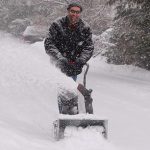As the nights get colder and longer, your lawn is preparing to go dormant for the year. Dormant lawns don’t need water, making any further sprinkler usage a waste of your time. On top of that, as temperatures drop, dangers to your sprinkler system may arise.

Sprinkler, courtesy Flickr user Phu Son.
Different Methods of Winterization
There are three different methods of winterizing your sprinkler system. The method you choose is dependent on the equipment installed. Manual sprinkler systems have to be treated differently than an automatic sprinkler systems. Many systems are limited by built-in equipment.
- Manual Drain: This method is for systems that have drains that can only be operated manually, and need to be opened one at a time by hand.
- Automatic Drain: Some systems have automatic drains built in that activate when water pressure drops below a certain point, usually around 10 PSI. These still require some interaction or your part to drain and winterize properly though. The methods differ a bit from manual draining.
- Blow Out Method: This should only be performed by a trained sprinkler technician, but it’s worth mentioning so you know what you might be getting in to. This method involves using highly-compressed air to blow the water out through the sprinkler heads. It’s a bit messy and complicated, as well as dangerous, which is why it’s best left to the pros. It’s also often used it the sprinkler system type cannot be positively identified.
Can You Winterize Your Sprinkler System on your Own?
You can winterize your sprinkler on your own, but a lot of it depends on your level of comfort with the system. Of course, there are other thing to consider as well:
- Sometimes the draining process requires specific tools, which you may or may not have on hand.
- It requires a good amount of time.
- Improper training can result in serious damage to the system.
Why Winterization is Necessary
You really can’t choose not to winterize. Failing to drain your sprinkler system can result in burst pipes. In many climates, PVC piping is used in sprinklers. This piping is rigid, and very susceptible to cracking when the water inside freezes. Sprinkler systems in cooler climates often use polyethylene pipes, which are black pipes that are flexible. These can still crack and break if water freezes up inside. On top of that, water freezing in the backflow assembly can crack the brass assembly, which can be much more expensive to replace than a length of pipe.
So How Do You Go About Winterizing Your Sprinkler System?
It’s a complicated process, to be sure. Instead of us trying to walk you through them, let’s go right to the experts for directions:
- This pdf provides some diagrams an step-by-step instructions.
- The guys at Sprinkler Warehouse provide a DIY guide, although they still recommend you having professionals involved.
- Hunter Industries are the professionals yu’d call for sprinkler repair, but they also provide some DIY help if you need it.
With cold nights rolling in, it’s only a matter of time before the ground starts freezing. You’ve only got a few weeks left until the freeze reaches far enough down to your sprinkler system, so make sure to winterize it as soon as possible, especially if we experience some early drops in temperature. It beats having to fix it come spring time.






